Throughout The Watergate Scandal, Richard Nixon And His Supporters Accused The Press Of Being Biased



Throughout the Watergate scandal, Richard Nixon and his supporters accused the press of being biased against his administration. In response to the criticism, Time, which had done significant investigative work on Watergate, took a moment for self-reflection with a July 8, 1974, cover story examining the press’ role in the event. Weighing the notion that the press had become too involved for its own good, the magazine still concluded that further investigation was necessary:
“If the press were to stop digging, analyzing and attempting to keep the record straight, the investigative momentum could easily falter once more. The press can help assure that the constitutional process continues to function. After all that has happened, the country is entitled to a definitive verdict.”
Nevertheless, accusations persisted that Time and other publications were merely pursuing a liberal agenda. In February 1976 Reed Irvine and his conservative organization Accuracy in Media bought a full-page ad in the Washington Post to print a story alleging that Democratic National Committee officials knew about plans to break into the Watergate offices beforehand. The ad implied that the DNC was something other than an innocent victim and that the press had refused to make this assertion for partisan reasons. In this memo from Time’s Washington Bureau correspondent Hays Gorey to his editors, Gorey outlines the investigation done into the potential story and defends the consensus among his colleagues that it did not merit publication. He writes:
“I’m sure Reed Irvine can wow audiences by telling this story and claiming it is news being covered up. But where are his facts? Hundreds of Watergate stories went unwritten and unpublished because there were no facts to support them. This is one.“
Time July 8, 1974 cover reprint. Time Inc. Records. Editor-in-Chief: Hedley Donovan Files: Subject Files: 1959-1979: Time: Bias. New-York Historical Society.
Hays Gorey to Hedley Donovan, Henry Grunwald, and D. Duncan. February 27, 1976. Time Inc. Records. Editor-in-Chief: Hedley Donovan Files: Subject Files: 1959-1979: [Time: Bias: Kennedy and Nixon]. New-York Historical Society.
Processing of the Time Inc. Archive is made possible through the generous support of the Henry Luce Foundation
More Posts from Philosophical-amoeba and Others

Black Holes are not so Black (Part 3) - Gravitational Waves
The existence of Gravitational Waves have been confirmed. But you probably have heard that. In this post, we will break down this profound discovery into comprehend-able chunks.
This is going to be a amazing journey. Ready ?
Redefining Gravity
When we usually talk of Gravitation we are bound to think like Newton, where objects are assumed to exerting a force upon each other.
Like imaginary arrows of force in space. But this picture, although good for high school crumbled, with the advent of Einstein’s theory of Relativity.

What is the Space-Time Fabric?
Think of space-time fabric as an actual cloth of fabric. ( An analogy )
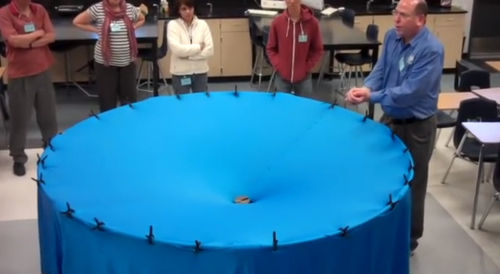
When you place an object on the fabric, the cloth curves. This is exactly what happens in the solar system as well.

The sun with such a huge mass bends the space-time fabric. And the earth and all the planets are kept in orbit by following this curvature that has been made by the sun.
Attributing to the various masses of objects, the way they bend this fabric also varies.
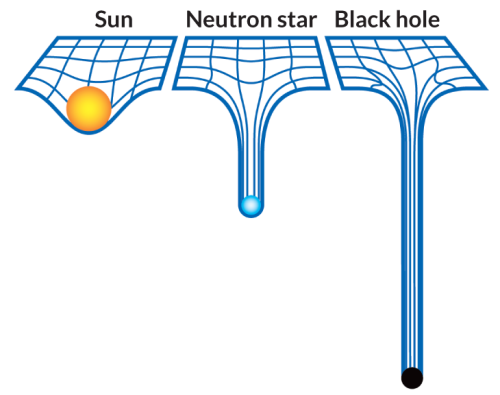
What are Gravitational Waves?
If you drop an object in a medium such as water, they produce ripples that propagate as waves through the medium.

Similarly, Gravitational waves are ripples in space-time fabric produced when you drag heavy objects through space time.
And the nature of these waves is that they don’t require a medium to propagate.
How do you make one?
Everything with mass/energy can create these waves.

Source
Two persons dancing around each other in space too can create gravitational waves. But the waves would be extremely faint.
You need something big and massive accelerating through space-time in order to even detect them.

And orbiting binary stars/black holes are valuable in this retrospect.
How can you detect them?
Let’s turn to the problem to detecting them assuming you do find binary stars/black-holes in the wondrous space to suite your needs.
Well, for starters you cannot use rocks/ rulers to measure them because as the space expands and contracts, so do the rocks. ( the distances will remain same in both the cases )

Here’s where the high school fact that the speed of Light is a constant no matter what plays an important and pivotal role.
If the space expands, the time taken for light to reach from A to B would be longer. And if it contracts, the time taken for it to reach from A to B would be smaller.

PC: PHDComics
By allowing the light waves from the contraction and expansion to interfere with each other, such as done in any interferometry experiment we can detect the expansion or contraction. Voila!
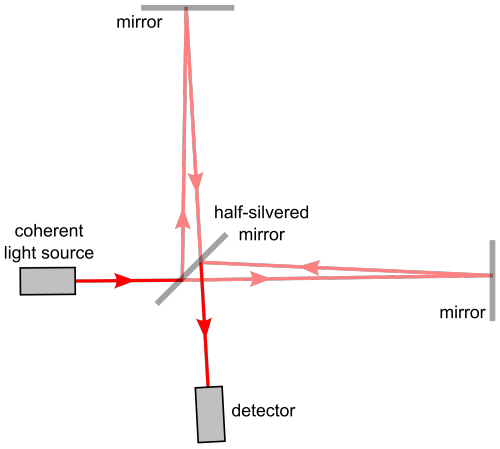
And this is exactly what they did! ( on a macroscopic level ) at LIGO (Laser Interferometer Gravitational-Wave Observatory)
14 September 2015

Two Black Holes with masses of 29 and 36 solar masses merged together some 1.3 Billion light years away.
Two Black Holes colliding is the header animation of the ‘Black Holes are not so Black Series’, in case if you haven’t noticed.

The merger of these two black holes results in the emission of energy equivalent to 3 solar masses as Gravitational Waves.
This signal was seen by both LIGO detectors, in Livingston and Hanford, with a time difference of 7 milliseconds.
And with the measurement of this time difference, physicists have pronounced the existence of Gravitational Waves.
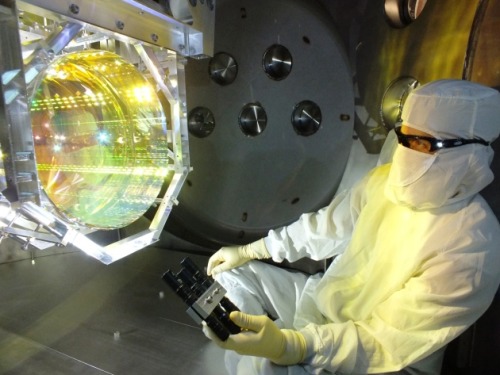
Source
All this is most certainly easily said than done and requires meticulous and extensive research, not to mention highly sensitive instruments.
Had they not have measured this time difference, we might have had to wait for the merger for more massive black holes to collide and maybe even build more sensitive instruments to detect these waves.
And Einstein predicted this a 100 years back!

Mind Blown!
Note: Hope you are able to understand and appreciate the profundity of the discovery done by mankind.
** All animations used here are merely for Educational purposes. If you have any issues, please write to us at : 153armstrong@gmail.com
Tough as a Tardigrade
Without water, a human can only survive for about 100 hours. But there’s a creature so resilient that it can go without it for decades. This one millimeter animal can survive both the hottest and coldest environments on Earth, and can even withstand high levels of radiation. This is the tardigrade, and it’s one of the toughest creatures on Earth, even if it does look more like a chubby, eight-legged gummy bear.

Most organisms need water to survive. Water allows metabolism to occur, which is the process that drives all the biochemical reactions that take place in cells. But creatures like the tardigrade, also known as the water bear, get around this restriction with a process called anhydrobiosis, from the Greek meaning life without water. And however extraordinary, tardigrades aren’t alone. Bacteria, single-celled organisms called archaea, plants, and even other animals can all survive drying up.

For many tardigrades, this requires that they go through something called a tun state. They curl up into a ball, pulling their head and eight legs inside their body and wait until water returns. It’s thought that as water becomes scarce and tardigrades enter their tun state, they start synthesize special molecules, which fill the tardigrade’s cells to replace lost water by forming a matrix.

Components of the cells that are sensitive to dryness, like DNA, proteins, and membranes, get trapped in this matrix. It’s thought that this keeps these molecules locked in position to stop them from unfolding, breaking apart, or fusing together. Once the organism is rehydrated, the matrix dissolves, leaving behind undamaged, functional cells.

Beyond dryness, tardigrades can also tolerate other extreme stresses: being frozen, heated up past the boiling point of water, high levels of radiation, and even the vacuum of outer space. This has led to some erroneous speculation that tardigrades are extraterrestrial beings.

While that’s fun to think about, scientific evidence places their origin firmly on Earth where they’ve evolved over time. In fact, this earthly evolution has given rise to over 1100 known species of tardigrades and there are probably many others yet to be discovered. And because tardigrades are so hardy, they exist just about everywhere. They live on every continent, including Antarctica. And they’re in diverse biomes including deserts, ice sheets, the sea fresh water, rainforests, and the highest mountain peaks. But you can find tardigrades in the most ordinary places, too, like moss or lichen found in yards, parks, and forests. All you need to find them is a little patience and a microscope.

Scientists are now to trying to find out whether tardigrades use the tun state, their anti-drying technique, to survive other stresses. If we can understand how they, and other creatures, stabilize their sensitive biological molecules, perhaps we could apply this knowledge to help us stabilize vaccines, or to develop stress-tolerant crops that can cope with Earth’s changing climate.

And by studying how tardigrades survive prolonged exposure to the vacuum of outer space, scientists can generate clues about the environmental limits of life and how to safeguard astronauts. In the process, tardigrades could even help us answer a critical question: could life survive on planets much less hospitable than our own?
From the TED-Ed Lesson Meet the tardigrade, the toughest animal on Earth - Thomas Boothby
Animation by Boniato Studio

Farming amoebae carry around detoxifying food
Five years ago, the Queller-Strassmann lab at Rice University, now at Washington University in St. Louis, demonstrated that the social amoeba Dictyostelium discoideum – affectionately nicknamed “Dicty” – can maintain a crop of food bacteria from generation to generation, giving these farmers an advantage when food is scarce.
Now, new research from the same team shows that these microscopic farmers also rely on their symbiotic bacteria to protect themselves from environmental toxins, a little-studied but increasingly clear role microbes can play for their hosts.
Research scientist Debra Brock led the new work, published April 20 in the Proceedings of the Royal Society B.
These amoebae are content to be loners when food is abundant, but when it’s depleted they come together in the tens of thousands to cooperate. They transform into a mobile slug that migrates in search of fairer conditions and then produces hardy spores to release into the environment and wait out the lean times.
The slug has a tiny pool of specialized cells, called sentinels, that protect it from pests and poisons by ferrying them away.
“The sentinel cells pass through the body, mopping up toxins, bacteria, and essentially serving as a liver, a kidney, and innate immune system and being left behind in the slime trail,” said Joan Strassmann, PhD, the Charles Rebstock Professor of Biology in Arts & Sciences.
Debra A. Brock, W. Éamon Callison, Joan E. Strassmann, David C. Queller. Sentinel cells, symbiotic bacteria and toxin resistance in the social amoebaDictyostelium discoideum. Proceedings of the Royal Society B: Biological Sciences, 2016; 283 (1829): 20152727 DOI: 10.1098/rspb.2015.2727
The social amoeba Dictyostelium discoideum has both solitary and communal life stages. As long as food is abundant, it lives on its own, but when food is scarce the amoebae seek one another out. Together they form a slug that migrates toward the light and then a fruiting body that disperses spores from atop a stalk. The fruiting bodies are pictured here. Credit: Strassmann/Queller lab
A nurse has heart attack and describes what she felt like when having one

I am an ER nurse and this is the best description of this event that I have ever heard.
FEMALE HEART ATTACKS
I was aware that female heart attacks are different, but this is description is so incredibly visceral that I feel like I have an entire new understanding of what it feels like to be living the symptoms on the inside. Women rarely have the same dramatic symptoms that men have… you know, the sudden stabbing pain in the chest, the cold sweat, grabbing the chest & dropping to the floor the we see in movies. Here is the story of one woman’s experience with a heart attack:
"I had a heart attack at about 10:30 PM with NO prior exertion, NO prior emotional trauma that one would suspect might have brought it on. I was sitting all snugly & warm on a cold evening, with my purring cat in my lap, reading an interesting story my friend had sent me, and actually thinking, ‘A-A-h, this is the life, all cozy and warm in my soft, cushy Lazy Boy with my feet propped up. A moment later, I felt that awful sensation of indigestion, when you’ve been in a hurry and grabbed a bite of sandwich and washed it down with a dash of water, and that hurried bite seems to feel like you’ve swallowed a golf ball going down the esophagus in slow motion and it is most uncomfortable. You realize you shouldn’t have gulped it down so fast and needed to chew it more thoroughly and this time drink a glass of water to hasten its progress down to the stomach. This was my initial sensation–the only trouble was that I hadn’t taken a bite of anything since about 5:00 p.m.
After it seemed to subside, the next sensation was like little squeezing motions that seemed to be racing up my SPINE (hind-sight, it was probably my aorta spasms), gaining speed as they continued racing up and under my sternum (breast bone, where one presses rhythmically when administering CPR). This fascinating process continued on into my throat and branched out into both jaws. ‘AHA!! NOW I stopped puzzling about what was happening – we all have read and/or heard about pain in the jaws being one of the signals of an MI happening, haven’t we? I said aloud to myself and the cat, Dear God, I think I’m having a heart attack! I lowered the foot rest dumping the cat from my lap, started to take a step and fell on the floor instead. I thought to myself, If this is a heart attack, I shouldn’t be walking into the next room where the phone is or anywhere else… but, on the other hand, if I don’t, nobody will know that I need help, and if I wait any longer I may not be able to get up in a moment.
I pulled myself up with the arms of the chair, walked slowly into the next room and dialed the Paramedics… I told her I thought I was having a heart attack due to the pressure building under the sternum and radiating into my jaws. I didn’t feel hysterical or afraid, just stating the facts. She said she was sending the Paramedics over immediately, asked if the front door was near to me, and if so, to un-bolt the door and then lie down on the floor where they could see me when they came in. I unlocked the door and then laid down on the floor as instructed and lost consciousness, as I don’t remember the medics coming in, their examination, lifting me onto a gurney or getting me into their ambulance, or hearing the call they made to St. Jude ER on the way, but I did briefly awaken when we arrived and saw that the radiologist was already there in his surgical blues and cap, helping the medics pull my stretcher out of the ambulance. He was bending over me asking questions (probably something like ‘Have you taken any medications?’) but I couldn’t make my mind interpret what he was saying, or form an answer, and nodded off again, not waking up until the Cardiologist and partner had already threaded the teeny angiogram balloon up my femoral artery into the aorta and into my heart where they installed 2 side by side stints to hold open my right coronary artery.
I know it sounds like all my thinking and actions at home must have taken at least 20-30 minutes before calling the paramedics, but actually it took perhaps 4-5 minutes before the call, and both the fire station and St Jude are only minutes away from my home, and my Cardiologist was already to go to the OR in his scrubs and get going on restarting my heart (which had stopped somewhere between my arrival and the procedure) and installing the stents. Why have I written all of this to you with so much detail? Because I want all of you who are so important in my life to know what I learned first hand.
1. Be aware that something very different is happening in your body, not the usual men’s symptoms but inexplicable things happening (until my sternum and jaws got into the act). It is said that many more women than men die of their first (and last) MI because they didn’t know they were having one and commonly mistake it as indigestion, take some Maalox or other anti-heartburn preparation and go to bed, hoping they’ll feel better in the morning when they wake up… which doesn’t happen. My female friends, your symptoms might not be exactly like mine, so I advise you to call the Paramedics if ANYTHING is unpleasantly happening that you’ve not felt before. It is better to have a ‘false alarm’ visitation than to risk your life guessing what it might be! 2. Note that I said ‘Call the Paramedics.’ And if you can take an aspirin. Ladies, TIME IS OF THE ESSENCE! Do NOT try to drive yourself to the ER - you are a hazard to others on the road. Do NOT have your panicked husband who will be speeding and looking anxiously at what’s happening with you instead of the road. Do NOT call your doctor – he doesn’t know where you live and if it’s at night you won’t reach him anyway, and if it’s daytime, his assistants (or answering service) will tell you to call the Paramedics. He doesn’t carry the equipment in his car that you need to be saved! The Paramedics do, principally OXYGEN that you need ASAP. Your Dr. will be notified later. 3. Don’t assume it couldn’t be a heart attack because you have a normal cholesterol count. Research has discovered that a cholesterol elevated reading is rarely the cause of an MI (unless it’s unbelievably high and/or accompanied by high blood pressure). MIs are usually caused by long-term stress and inflammation in the body, which dumps all sorts of deadly hormones into your system to sludge things up in there. Pain in the jaw can wake you from a sound sleep. Let’s be careful and be aware. The more we know the better chance we could survive to tell the tale.“
Reblog, repost, Facebook, tweet, pin, email, morse code, fucking carrier pigeon this to save a life! I wish I knew who the author was. I’m definitely not the OP, actually think it might be an old chain email or even letter from back in the day. The version I saw floating around Facebook ended with “my cardiologist says mail this to 10 friends, maybe you’ll save one!” And knew this was way too interesting not to pass on.
Artist profile: Gerard Sekoto
‘Art is the spark, the illumination which is socially significant for it brings about understanding’ – Gerard Sekoto (1913–1993)

Gerard Sekoto was born in Botshabelo, Mpumalanga province, in 1913, the year in which the Natives Land Act dispossessed many black South Africans of their ancestral lands. In 1938 Sekoto moved to Sophiatown, Johannesburg. He held his first solo exhibition the following year, and in 1940 the Johannesburg Art Gallery purchased his work Yellow Houses – A Street in Sophiatown (1939–1940). It was the first painting by a black South African artist to be acquired by a South African art institution, although Sekoto had to pose as a cleaner to see his own painting hanging in the gallery.

Sekoto based this painting, titled Song of the Pick (1946), on a photograph taken in the 1930s of black South African workers labouring under the watchful eye of a white foreman standing behind them. However, in his painting the dynamic has changed. Sekoto has enhanced the grace and power of the labourers, turning them to confront the small and puny figure of the overseer, who appears about to be impaled by their pickaxes.
Sekoto painted this work in the township of Eastwood in Pretoria, shortly before moving to Paris in what became a lifelong exile from South Africa. During the 1980s, postcard-sized reproductions of this iconic painting were widely distributed in South Africa, as both a badge of honour and a source of inspiration in the struggle against apartheid.
Explore a diverse range of art stretching back 100,000 years in our exhibition South Africa: the art of a nation (27 October 2016 – 26 February 2017).
Exhibition sponsored by Betsy and Jack Ryan
Logistics partner IAG Cargo
Song of the Pick, 1946. Image © Iziko Museums of South Africa, Art Collections, Cape Town. Photo by Carina Beyer.
Song of the Pick was based on this image, taken by photographer Andrew Goldie in the 1930s.
Chai Tea
Word for tea in most of the world’s languages are all ultimately related, belonging to two groups of terms.
“Tea” itself belongs to one of those groups. It was a borrowing from Dutch thee, in turn from tê, the reading of 茶 in the Amoy dialect of Min Nan. Those languages whose introduction to tea was primaraly from Dutch traders typically use words likewise derived via the Dutch thee. The Polish herbata is also part of this family, though slightly obscured, being a borrowing from the Latin herba thea.
The other major group is represented by the word chai, a more recent borrowing in English. Chai was borrowed from the Hindi cāy, which in turn came from a Chinese dialect with a form similar to Mandarin chá. Languages that use chai-type terms generally were first introduced to tea through overland trade, ultimately to northern China, while those that use tea-type terms were generally introduced to it via sea trade, from Southern China.
Both tê and chá are derived from the same Middle Chinese form, ultimately derived from Proto-Sino-Tibetan *s-la “leaf”.

Samurai armour.
A chart I made showing the names of the various main components of a suit of “modern samurai armour” or tosei gusoku. Tosei gusoku refers to armour worn by samurai that began to appear during the middle of the Muromachi Period (1337-1573) with the introduction of firearms.
A full suit of tosei gusoku as shown in my chart would have weighed in at around 30 kilograms or so including weapons - there is after all a considerable amount of iron plates and lacing!
Lower class samurai such as foot soldiers (ashigaru) would have carried their own rations, bedding, and other equipment, but their armour was somewhat lighter being generally less ornamented.
At this point in time, known in Japanese history as the Sengoku Period or the Warring States Period, the most common samurai weapon was the spear followed by the bow and arrow. The sword at this point in time was a secondary weapon relied upon during close combat.
The sword carried during this period was the longer, gracefully curved tachi and was worn edge down on the left side supported either by it’s own tachi mounting (tachi koshirae) or by using a special leather “sling” (koshiate) if it was mounted without hangers (ashi).
Another shorter sword called a chisagatana - literally “little sword” - was carried together with the tachi at the left hip up until the Momoyama period (1573-1603) when it was abandoned. The chisagatana was originally a throw away weapon reserved for use by conscript foot soldiers (ashigaru), but higher ranking samurai soon took up the carrying of one as a back up weapon.
Higher ranked samurai, those in charge of troops and generals in particular, also carried a short stout blade called a metezashi at the right hip, with the handle facing forwards. This weapon was designed for extreme close combat and used to penetrate the weak spots in an opponents armour. When swords were crossed, the metezashi could be drawn with the left hand and thrust into the opponent’s armpits. It could also be drawn with the right hand and thrown underarm in an instant to distract and stun an opponent before following up with the sword.
© James Kemlo
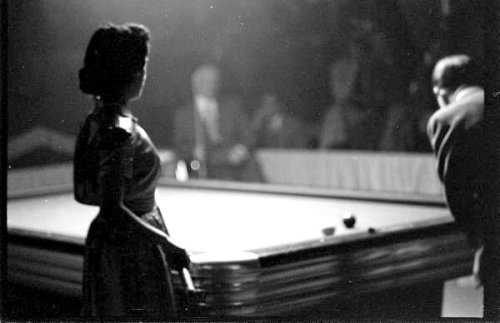
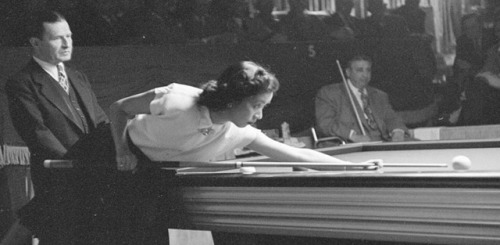
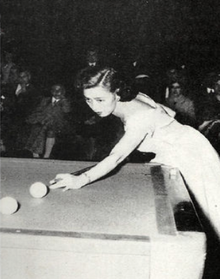

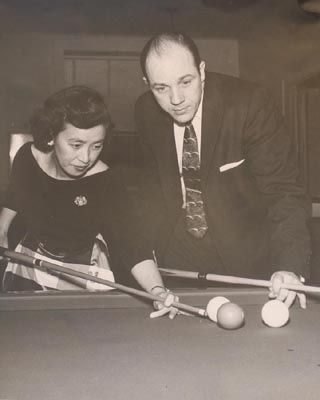
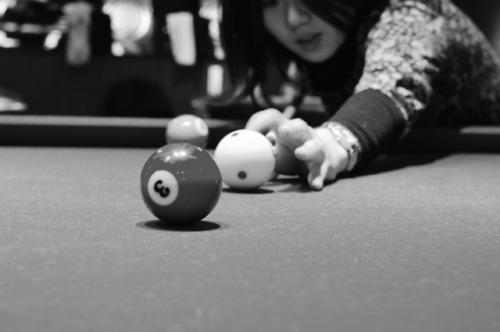
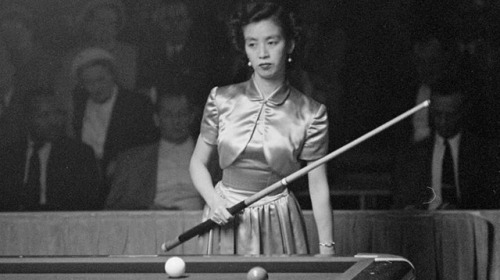
“Men want to beat me. I play men, six, seven hours a day. Men… they do not beat me.”
- Masako “Katsy” Katsura, first woman to compete for a world’s title in billiards
The “First Lady of Billiards” learned from her brother-in-law and in the 50s became Japan’s only female billiards pro. She paved the way for women to come, then left the spotlight and lived a quiet life. She died in 1995.
-
 sashastergiou liked this · 5 years ago
sashastergiou liked this · 5 years ago -
 mydearest-friend liked this · 6 years ago
mydearest-friend liked this · 6 years ago -
 philosophical-amoeba reblogged this · 7 years ago
philosophical-amoeba reblogged this · 7 years ago -
 purpleku77 liked this · 8 years ago
purpleku77 liked this · 8 years ago -
 skcirthinq reblogged this · 8 years ago
skcirthinq reblogged this · 8 years ago -
 mountainmint liked this · 8 years ago
mountainmint liked this · 8 years ago -
 lblaetzprice liked this · 8 years ago
lblaetzprice liked this · 8 years ago -
 skywithflame liked this · 8 years ago
skywithflame liked this · 8 years ago -
 route22ny liked this · 8 years ago
route22ny liked this · 8 years ago -
 ladydeirdrewaggon liked this · 8 years ago
ladydeirdrewaggon liked this · 8 years ago -
 houghtonlib liked this · 8 years ago
houghtonlib liked this · 8 years ago -
 saratogahistoryroom liked this · 8 years ago
saratogahistoryroom liked this · 8 years ago -
 atomic-komodo reblogged this · 8 years ago
atomic-komodo reblogged this · 8 years ago -
 greatspacecoaster reblogged this · 8 years ago
greatspacecoaster reblogged this · 8 years ago -
 rever-en-gris reblogged this · 8 years ago
rever-en-gris reblogged this · 8 years ago -
 refractedglade liked this · 8 years ago
refractedglade liked this · 8 years ago -
 vestriis reblogged this · 8 years ago
vestriis reblogged this · 8 years ago -
 forgetful-amoeba liked this · 8 years ago
forgetful-amoeba liked this · 8 years ago -
 the1920sinpictures liked this · 8 years ago
the1920sinpictures liked this · 8 years ago -
 micahaphone liked this · 8 years ago
micahaphone liked this · 8 years ago -
 redbullandlaptops-blog liked this · 8 years ago
redbullandlaptops-blog liked this · 8 years ago -
 theren liked this · 8 years ago
theren liked this · 8 years ago -
 bobbycaputo liked this · 8 years ago
bobbycaputo liked this · 8 years ago -
 worldenoughtime reblogged this · 8 years ago
worldenoughtime reblogged this · 8 years ago -
 norealbusinessbeinghere liked this · 8 years ago
norealbusinessbeinghere liked this · 8 years ago -
 gawoam reblogged this · 8 years ago
gawoam reblogged this · 8 years ago -
 ourbw reblogged this · 8 years ago
ourbw reblogged this · 8 years ago -
 trilobitey-blog1 liked this · 8 years ago
trilobitey-blog1 liked this · 8 years ago -
 kdw8215 liked this · 8 years ago
kdw8215 liked this · 8 years ago -
 lightbird reblogged this · 8 years ago
lightbird reblogged this · 8 years ago -
 backbenttulips liked this · 8 years ago
backbenttulips liked this · 8 years ago -
 archa30l0gy liked this · 8 years ago
archa30l0gy liked this · 8 years ago -
 putinyoudown reblogged this · 8 years ago
putinyoudown reblogged this · 8 years ago -
 allimba liked this · 8 years ago
allimba liked this · 8 years ago -
 toughnessemperor reblogged this · 8 years ago
toughnessemperor reblogged this · 8 years ago -
 toughnessemperor liked this · 8 years ago
toughnessemperor liked this · 8 years ago -
 mlq1516 liked this · 8 years ago
mlq1516 liked this · 8 years ago -
 lizzieylovesherbae liked this · 8 years ago
lizzieylovesherbae liked this · 8 years ago -
 randyrust liked this · 8 years ago
randyrust liked this · 8 years ago -
 your-instructions-from-moscow reblogged this · 8 years ago
your-instructions-from-moscow reblogged this · 8 years ago -
 your-instructions-from-moscow liked this · 8 years ago
your-instructions-from-moscow liked this · 8 years ago -
 nyhistory reblogged this · 8 years ago
nyhistory reblogged this · 8 years ago
A reblog of nerdy and quirky stuff that pique my interest.
291 posts





